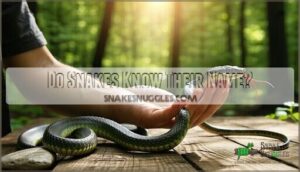This site is supported by our readers. We may earn a commission, at no cost to you, if you purchase through links.
 Your ball python coils around your arm during interaction, and you wonder: is this affection, or just your snake seeking warmth? The question of whether snakes can form emotional bonds with their owners remains one of the most debated topics among reptile enthusiasts.
Your ball python coils around your arm during interaction, and you wonder: is this affection, or just your snake seeking warmth? The question of whether snakes can form emotional bonds with their owners remains one of the most debated topics among reptile enthusiasts.
Unlike dogs that wag their tails or cats that purr, snakes communicate through subtle behaviors that aren’t rooted in mammalian emotions. Research shows that snakes lack the brain structures responsible for attachment and affection—specifically, they don’t possess a developed limbic system like mammals do.
Yet many snake owners report that their pets seem to recognize them and behave differently around familiar people. Understanding what’s actually happening when your snake appears to seek you out requires looking beyond our natural tendency to interpret animal behavior through a human lens.
Table Of Contents
- Key Takeaways
- Can Snakes Show Affection?
- Do Snakes Have Emotions and Feelings?
- Do Snakes Recognize Their Owners?
- Do Snakes Know Their Name?
- Frequently Asked Questions (FAQs)
- What are some signs that a snake is stressed or unhappy?
- How can I make my snake more comfortable with being handled?
- What is the lifespan of different snake species kept as pets?
- How long do pet snakes typically live?
- What snake species bond best with humans?
- How often should I handle my snake?
- Can snakes feel stress from too much interaction?
- Do snakes need enrichment in their environment?
- Conclusion
Key Takeaways
- Snakes don’t possess the brain structures for affection or emotional bonding like mammals, but they recognize their owners primarily through scent using their vomeronasal organ, not through sight or sound.
- What looks like affection—tongue flicking, approaching you, or coiling around your arm—is actually environmental exploration, warmth-seeking, or familiarity-based behavior rather than emotional attachment.
- Regular handling helps snakes become calmer around their owners by learning you’re safe through repeated exposure, though this reflects habituation and trust rather than love or emotional connection.
- Snakes do experience basic feelings like fear, stress, boredom, and pain, which show up through defensive behaviors, hiding, lethargy, or changes in eating patterns—making proper care and enrichment essential for their well-being.
Can Snakes Show Affection?
When you spend time with your snake, you might wonder if it notices you the way other pets do. There are certain little actions that can tell you what a snake is feeling.
Let’s look at two common signs that could mean your snake feels some comfort in your presence.
Tongue Flicking
Tongue flicks are a snake’s way of “listening” to the world, collecting every little scent with each quick swipe. This instinctual behavior, called tongue flicking, lets your snake sample the air and decode its surroundings through a sophisticated sensory organ.
While some owners hope this means snake affection, what’s really happening is environmental exploration and keen sensory perception. Rather than a sign of animal affection or emotion, your snake’s frequent tongue flicking is about recognizing familiar scents and ensuring survival in its ever-changing world.
Approaching You
After those curious flicks of the tongue, it’s only natural to wonder what’s going through your snake’s mind as it glides closer to you.
Snake proximity can feel like a gesture of snake affection, yet approaching you is linked more to body language cues, environmental factors like warmth, or simple owner interaction, rather than a desire to show affection or deepen the snake-owner relationship.
Do Snakes Have Emotions and Feelings?
Snakes experience the world differently from us, but they do show certain feelings through their behavior. You might notice signs that point to fear, sadness, boredom, or even pain.
Here’s how these emotions can show up in your snake’s life.
Fear
Fear Responses shape how your snake reacts to new sights and sounds. When stress triggers arise, your pet may show:
- Rapid tongue-flicking to assess the threat
- Hissing as a warning
- Coiling tightly, ready to defend
- Attempting to flee the scene
Recognizing these defensive behaviors helps you reduce snake anxiety, foster trust, and create a calmer environment. Understanding [snake emotional range]() is essential for effective snake care and interaction.
Sadness And/or Depression
You might wonder if a snake’s stillness means sadness or depression. In truth, snakes show limited emotional capacity—they don’t demonstrate sadness like a pet dog.
If your snake spends too much time hidden or inactive, it may signal stress factors or unmet needs. Supporting their mental health with proper animal welfare and habitat enrichments helps promote a balanced emotional state.
Boredom
Even in the quiet world of snakes, regular Environmental Enrichment makes all the difference. Without variety and snake stimulation—think climbing branches or new hiding places—boredom can set in, often showing up as lethargy or repetitive behaviors like glass surfing.
Since emotional capacity in snakes is limited, your role in Captive Care and Reptile Welfare is essential. Simple changes for snake mental stimulation, like weekly swaps of enrichment tools, help keep your snake content and healthy through positive snake enrichment and environmental enrichment.
Pain
Pain perception in snakes isn’t dramatic, but it’s very real—a key compass for their survival. You’ll notice subtle shifts: a sudden recoil, heightened defense, or a refusal to eat.
Some snake venoms even have Analgesic Properties, dampening pain through unique Venom Effects in other animals.
That’s why monitoring stress and pain is essential for snake care, Reptile Welfare, and overall snake health, creating an environment where distress rarely shadows animal welfare.
Do Snakes Recognize Their Owners?
How exactly do snakes recognize their owners? Research reveals that snake owner recognition happens primarily through scent—not sight or sound. When you manage your pet regularly, your snake learns your unique chemical signature using its vomeronasal organ, which processes scents collected through tongue flicking. This is reptile cognition at work, not emotional bonding.
Studies on snake scent recognition show fascinating patterns:
- Corn snakes in enriched environments investigated unfamiliar human scents 60% more than familiar managers, demonstrating clear scent discrimination
- Ball pythons showed no preference among different human scents in controlled tests
- Garter snakes displayed sophisticated chemical recognition, distinguishing even altered versions of their own scent
- Regular management increases your snake’s ability to identify your specific chemical cues
- Pet snake behavior changes with familiarity—snakes strike and hiss less around regular managers
While snakes recognize their owners through consistent exposure, this reflects snake socialization rather than affection. Your snake won’t identify your face or voice, but through patient interaction, it learns you’re safe. Understanding reptile memory is key to recognizing these patterns in pet snakes.
Do Snakes Know Their Name?
You might call your snake “Buttons” or “Noodle,” but does your pet actually know its name the way a dog perks up when you say “Max”? The short answer is no—snakes lack the brain structures needed for name recognition. Snake hearing relies on vibrations rather than traditional auditory cues, so vocal associations don’t form like they do in mammals.
However, repeated exposure to your voice during feeding or touching can condition your snake to respond calmly to familiar sound patterns. This isn’t about understanding language—it’s basic species communication through habituation.
| Sensory System | What Snakes Detect | Owner Recognition Role |
|---|---|---|
| Scent (Jacobson’s organ) | Chemical signatures | Primary—snakes recognize their owners this way |
| Vibration detection | Ground movement, low frequencies | Secondary—familiar touching patterns |
| Vocal patterns | Repetitive sound vibrations | Minimal—may reduce stress through familiarity |
While snake emotions don’t include affection, proper snake care and wellbeing benefits from consistent interaction. Your snake won’t come when called, but owner recognition through scent makes you a trusted presence.
Frequently Asked Questions (FAQs)
What are some signs that a snake is stressed or unhappy?
When your snake starts hissing, striking, or displaying a gaping mouth, it’s reacting to something threatening in its space. More subtle stress indicators include refusing meals, hiding constantly, or showing unusual lethargy. Watch for these defensive behaviors—they’re your snake’s way of telling you something’s wrong.
Environmental factors like incorrect temperatures or humidity often trigger discomfort. A happy snake moves smoothly, eats regularly, and explores its habitat with curiosity.
How can I make my snake more comfortable with being handled?
Building trust through consistent management techniques starts with reading your snake’s body language. If you notice stress signals, keep sessions brief—just a few minutes daily.
Gentle touch and calm owner interaction help establish comfort zones, gradually strengthening the snake-owner relationship as your pet learns you’re safe.
What is the lifespan of different snake species kept as pets?
Different pet snake species age at remarkably different rates. Ball pythons can thrive for three decades with proper snake care and nutrition, while corn snakes usually reach 15-20 years.
Understanding reptile life expectancy helps snake owners plan for long-term commitment and relationship-building with their pets.
How long do pet snakes typically live?
Most pet snakes live between 15 and 30 years, depending on their species. Corn snakes usually reach 15-20 years, while ball pythons can hit 30 with proper snake care and nutrition.
Good husbandry maximizes reptile longevity.
What snake species bond best with humans?
Corn snakes, ball pythons, king snakes, and rat snakes tolerate human interaction well, making them popular pet preferences.
Their species temperament facilitates bonding techniques that strengthen the snake-owner relationship through consistent, gentle manipulation over time.
How often should I handle my snake?
You should interact with your snake two to three times weekly for about 10-15 minutes per session.
This interaction frequency fosters snake socialization and strengthens the snake-owner bond without causing stress.
Gentle touch and consistent owner interaction aid in bonding with a pet snake while respecting their need for rest.
Can snakes feel stress from too much interaction?
Like a candle burning too bright, snakes can absolutely feel stress from too much interaction. Watch for defensive behaviors and stress indicators—hissing, rapid tongue flicking, or hiding—which signal you’ve crossed their interaction thresholds.
Respecting snake touch limits and offering environmental enrichment helps prevent reptile burnout.
Do snakes need enrichment in their environment?
Yes, snakes benefit from environmental stimulation and habitat variety. Enrichment activities like different textures, hiding spots, and climbing branches support their cognitive abilities and animal welfare.
Snake exploration opportunities reduce stress and encourage natural behaviors, making sensory enrichment essential for their well-being.
Conclusion
Your snake’s behavior reveals a paradox: the connection you feel is real, even though can pet snakes be affectionate to their owners isn’t quite the right question. Snakes don’t bond through emotion—they respond to familiarity, routine, and safety.
What you’re witnessing isn’t affection as you know it, but something equally valuable: trust. Your snake’s calm demeanor around you proves you’ve created an environment where it feels secure. That’s not love—it’s respect, built through consistent care and understanding.
- https://animal-club.co.uk/snakes-recognise-owners/
- https://archive.imascientist.org.uk/animalj14-zone/question/do-ophidians-feel-any-emotional-attachment/
- https://vetmed.tamu.edu/news/pet-talk/reptile-emotions/
- https://www.reddit.com/r/snakes/comments/10k8ut6/do_yall_ever_feel_like_your_snakes_show_some_sort/
- https://pmc.ncbi.nlm.nih.gov/articles/PMC10884060/








